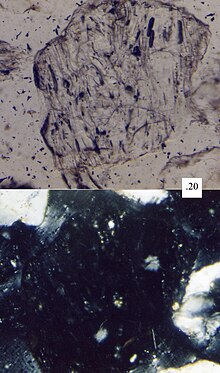Volcanic glass

A sand grain of volcanic glass under the petrographic microscope. Its amorphous nature makes it disappear in cross-polarized light (bottom frame). The scale box is in millimeters.
Volcanic glass is the amorphous (uncrystallized) product of rapidly cooling magma. Like all types of glass, it is a state of matter intermediate between the closely packed, highly ordered array of a crystal and the highly disordered array of liquid.[1] Volcanic glass may refer to the interstitial material, or matrix, in an aphanitic (fine-grained) volcanic rock, or to any of several types of vitreous igneous rocks.
Most commonly, it refers to obsidian, a rhyolitic glass with high silica (SiO2) content.[2]
Other types of volcanic glass include the following:
- Pumice, which is considered a glass because it has no crystal structure.
- Apache tears, a kind of nodular obsidian.
- Tachylite (also spelled tachylyte), a basaltic glass with relatively low silica content.
- Sideromelane, a less common form of tachylyte.
- Palagonite, a basaltic glass with relatively low silica content.
- Hyaloclastite, a hydrated tuff-like breccia of sideromelane and palagonite.
- Pele's hair, threads or fibers of volcanic glass, usually basaltic.
- Pele's tears, tear-like drops of volcanic glass, usually basaltic.
- Limu o Pele (Pele's seaweed), thin sheets and flakes of brownish-green to near-clear volcanic glass, usually basaltic.
References[]
- ^ Bates; Jackson (1984). Dictionary of Geological Terms (3rd ed.). American Geological Institute.CS1 maint: multiple names: authors list (link)
- ^ Reka, Arianit A.; Pavlovski, Blagoj; Lisichkov, Kiril; Jashari, Ahmed; Boev, Blazo; Boev, Ivan; Lazarova, Maja; Eskizeybek, Volkan; Oral, Ayhan; Jovanovski, Gligor; Makreski, Petre (23 October 2019). "Chemical, mineralogical and structural features of native and expanded perlite from Macedonia". Geologia Croatica. 72 (3): 215–21. doi:10.4154/gc.2019.18.
Categories:
- Volcanology
- Glass in nature
- Volcanic rocks
- Volcanology stubs